The Ultimate Guide to Choosing the Right Home Gym Flooring
Whether you’re creating a dedicated workout space in a spare room, converting a garage, or designing a personal fitness facility, your home gym flooring choice has an impact on everything from equipment stability and noise levels to injury prevention and the longevity of both your exercise gear and the structure beneath.
At Indigo Flooring, with our 65 years of combined experience in the flooring trade, we’ve completed numerous specialist gym installations for both residential and commercial clients across London and the Home Counties.
From home conversions to professional fitness facilities, we’ve seen how the correct floor specification makes the difference between a practical, long-lasting fitness environment and one plagued by ongoing issues. This comprehensive guide will walk you through everything you need to know about selecting, installing, and maintaining the perfect floor for your home workout space.
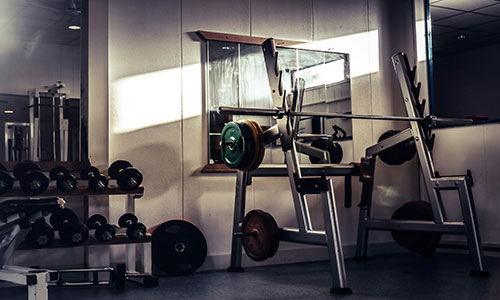
Why Standard Residential Flooring Doesn’t Work for Home Gyms
Standard residential flooring options like carpet, laminate, or engineered wood simply aren’t designed to withstand the unique challenges posed by exercise equipment and activities:
- Impact resistance: Dropped weights, jumping exercises and repeated footfall create forces that conventional flooring can’t absorb.
- Moisture management: Increased humidity and sweat require surfaces that won’t warp, stain or develop odours.
- Equipment stability: Exercise equipment needs stable, non-slip surfaces that won’t shift or compress unevenly.
- Sound transmission: Without proper acoustic properties, exercise noise can travel throughout your home.
- Subfloor protection: Your existing concrete or timber subfloor requires protection from damage.
The bottom line: To protect both your equipment and your home, purpose-built gym flooring is essential for any home gym.
Understanding Home Gym Flooring Options
Rubber remains the gold standard for most home gym applications, offering superior impact absorption, durability, and versatility. Options include:
Rolled Rubber
Available in thicknesses from 3mm to 12mm
- Typically sold in rolls 1.25m wide
- Minimal seams once installed
- Most cost-effective for covering larger spaces
Interlocking Rubber Tiles
Available in thicknesses from 10mm to 40mm
- Easy to reconfigure or replace damaged sections
- Ideal for oddly shaped spaces or rental properties
Rubber Mats
Available in thicknesses from 15mm to 40mm
- No adhesive required and rely on weight for stability
- Perfect for creating designated areas for specific activities
For general fitness areas, we recommend a minimum rubber flooring thickness of 8mm, which provides reliable cushioning and protection for most cardio and strength training equipment. In weightlifting zones or areas where heavy free weights are used, it’s best to go for at least 15mm to provide adequate shock absorption and to safeguard both your subfloor and equipment from damage
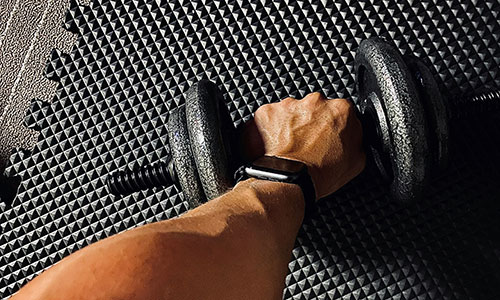
Vinyl Gym Flooring
Luxury vinyl flooring has emerged as a practical alternative for home gyms where aesthetics are prioritised alongside functionality:
Available in thicknesses from 2mm to 5mm
- Offers excellent moisture resistance
- Available in wood, stone and abstract designs
- Less impact absorption than rubber but more visually appealing
2.5mm vinyl planks with a 0.55mm wear layer provide sufficient durability for light to moderate gym use when properly installed over a suitable subfloor.
EVA Foam Tiles
Foam options provide a budget-friendly solution for lighter fitness activities:
Available in thicknesses from 10mm to 40mm
- Interlocking design for simple DIY installation
- Best suited for yoga, pilates, and bodyweight exercises
- Not recommended for heavy equipment or free weights
Specialised Sports Flooring
For dedicated athletes or specific sports, consider sprung wood systems for professional dance-style floors, artificial turf for functional fitness and sprint training, cushioned vinyl purpose-made for commercial gyms, and shock pads as underlayment systems designed to work beneath various floor finishes.
Key Considerations When Choosing Home Gym Flooring
Basement Gyms
Basement gyms present unique considerations that require careful planning. Potential moisture issues make vapour barriers essential to protect equipment and maintain air quality. Whilst concrete subfloors provide an excellent solid foundation for heavy equipment, they offer poor shock absorption, which may necessitate additional flooring solutions for comfort and joint protection. The limited natural light typical in basements makes colour choice particularly important for creating a bright, energising workout environment.
Garage Conversions
Garage conversions typically feature concrete floors that require levelling before installation to ensure a proper surface. Temperature fluctuations in these spaces can significantly affect material expansion and contraction, making it crucial to select appropriate flooring materials and installation methods. Vehicle oil and chemical contamination may also require thorough cleaning and potentially specialised treatment before any flooring installation can proceed.
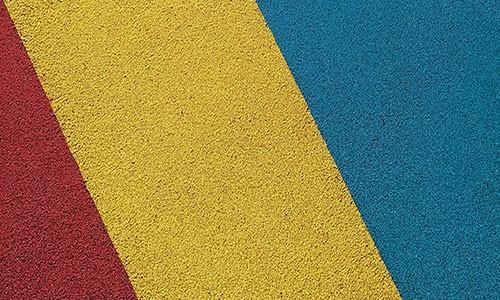
Spare Room Conversions
Spare room conversions involve wood joists and subfloors that require careful assessment for structural integrity to ensure they can support the intended use and any additional equipment weight. Potential noise transmission to rooms below must be considered, particularly if the space will be used for high-impact activities, which may necessitate sound-dampening measures. Existing skirting boards and door clearances also need to be evaluated, as these may require modification to accommodate new flooring materials and maintain proper functionality.
Exercise Type and Equipment
Your workout style directly impacts flooring requirements:
Weightlifting Areas
Minimum 15mm rubber thickness recommended
- Consider dedicated platforms for Olympic lifting
- Avoid foam products that compress under heavy loads
Cardio Zones
Minimum 8mm thickness for treadmills and other machines
- Focus on moisture resistance and easy cleaning
- Anti-vibration properties to reduce equipment noise
Functional Fitness
Non-slip surface essential for dynamic movements
- Consistent shock absorption across entire floor
- Sufficient area for movement without transitions between surfaces
Sound Transmission Concerns
Noise reduction is one of the most overlooked aspects of home gym flooring. Effective sound management strategies include floating floor systems that decouple the exercise surface from structural elements, acoustic underlayment with specialised rubber underlays, edge isolation to prevent sound transmission through walls, and mass-loaded barriers that add density to reduce transmission. For apartments or terraced houses, comprehensive acoustic solutions may require multiple elements working together.
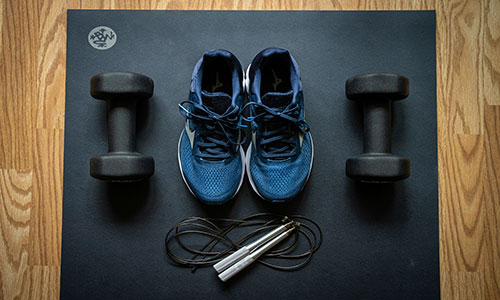
Installation Methods for Home Gym Flooring
The installation approach significantly impacts performance and longevity.
DIY-Friendly Options
Interlocking Systems
- No adhesive required
- Can be disassembled and moved
- Best for temporary installations or rental properties
Loose-Lay Solutions
- Rely on material weight for stability
- Simple to install without technical skills
- May require securing at transitions and perimeters
Professional Installation Recommended
Fully Adhered Systems
- Permanent installation with maximum stability
- Eliminates shifting or movement under equipment
- Allows for seamless appearance with minimal joints
Floating Acoustic Systems
- Critical for sound attenuation in multi-storey buildings
- Often involves multiple components working together
- Incorrect installation compromises acoustic performance
At Indigo Flooring, our team’s extensive experience with London’s diverse property types ensures we can handle even the most challenging installations with confidence.
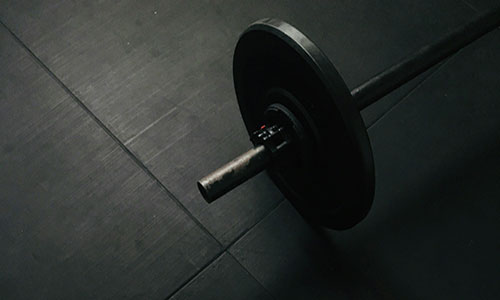
Maintenance Requirements for Different Flooring Types
Proper maintenance extends lifespan and preserves performance. For rubber flooring, daily sweeping removes abrasive particles while weekly damp mopping with pH-neutral cleaner maintains surfaces. Monthly deep cleaning with rubber-specific products preserves performance, and annual inspection addresses any loose areas. Avoid harsh chemicals, excessive water, and petroleum-based products.
Vinyl flooring requires daily sweeping with a soft brush to prevent scratching, weekly damp mopping with manufacturer-approved cleaner, and quarterly polishing with an appropriate refresher. Avoid abrasive scrubbers, steam cleaning, and wax-based products.
EVA foam needs wiping down with mild antibacterial spray after each use, weekly removal and cleaning underneath tiles, and replacement of individual damaged tiles as needed. Avoid soaking with water, harsh cleaners, and extended sun exposure.
Common Mistakes to Avoid When Installing Home Gym Flooring
Learning from others’ mistakes can save significant time and expense:
- Insufficient Thickness: Opting for thinner materials to save money often results in subfloor damage and premature replacement.
- Improper Acclimation: Most flooring materials need 24–72 hours to acclimate to your home’s temperature and humidity before installation.
- Inadequate Subfloor Preparation: Failing to address moisture issues, uneven surfaces, or structural concerns leads to premature failure.
- Ignoring Expansion: Flooring materials expand and contract with temperature and humidity changes, requiring appropriate gaps at perimeters.
- Skipping Moisture Testing: Particularly important for basement and ground floor installations where moisture can migrate through concrete.
- Mismatching Flooring to Activity: Using lightweight foam under heavy equipment or thin rubber for Olympic lifting can damage flooring.
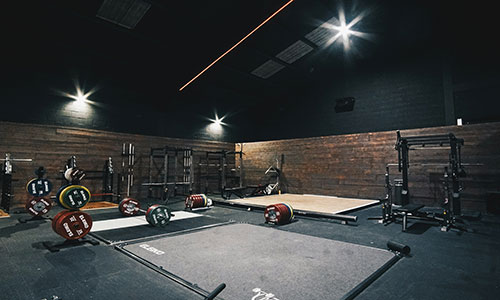
Sustainability Considerations for Gym Flooring
Environmental concerns are increasingly important, with several sustainable options available. Recycled rubber, made from repurposed vehicle tyres, diverts waste from landfills while providing extremely durable flooring. Natural rubber, harvested from renewable rubber trees, is biodegradable at end of lifecycle and offers similar performance to synthetic options.
Cork and sustainable wood provide renewable materials with excellent acoustic properties and warm, natural aesthetics, though they may require additional protective coatings for gym use. When you’re considering lifecycle impact, longer-lasting materials create less waste over time, local manufacturing reduces transportation emissions, and end-of-life recyclability varies significantly between products.
Transforming a Spare Room into a Multi-Purpose Home Gym
Requirements:
Converting a 4m x 3.5m spare bedroom into a home gym accommodating free weights, exercise bike, and a yoga area while preventing noise transmission to the bedroom below, and maintaining aesthetics suitable for occasional guest room use..
Challenges:
Tackling a first-floor location with timber joists in an original Victorian property with uneven floorboards, limited ceiling height (2.4m), and no opportunity to remove existing floorboards.
Solution:
A comprehensive assessment of the floor structure and levelling requirements, followed by the installation of 6mm acoustic rubber underlay throughout, 10mm commercial-grade rubber tiles in a weightlifting zone (2m x 2m area), 5mm luxury vinyl wood-effect planks in the remaining areas, acoustic isolation strip around the perimeter, and custom transition profiles between different flooring zones.
At Indigo Flooring, we’ve successfully completed similar transformations across London’s diverse property portfolio, from Victorian terraces to modern developments. Our experience with acoustic solutions and multi-zone installations makes us ideally placed to handle complex residential gym projects.
Specialist Requirements: Underfloor Heating and Home Gym Flooring
Homeowners increasingly want to combine comfort heating with functional exercise spaces, presenting unique challenges around maximum recommended thermal resistance, material stability under temperature fluctuations, and heat transfer efficiency through different materials.
Recommended solutions include thinner rubber (6–8mm) specifically rated for UFH compatibility, luxury vinyl products designed for UFH applications, and zoned solutions using different flooring types.
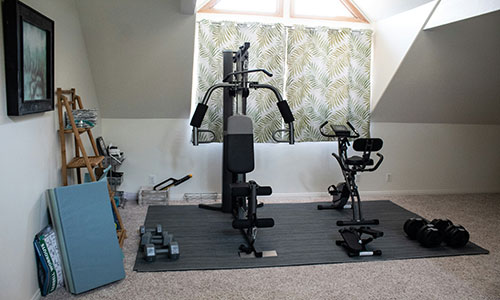
Making Your Final Decision: A Practical Approach
When selecting your home gym flooring, follow this structured approach to make the best choice for your needs. Begin by assessing your space thoroughly, taking accurate measurements and evaluating the subfloor condition to understand what preparation may be required. Next, define your activities clearly by listing all exercises and equipment you plan to use, which will help identify the maximum performance requirements your flooring must meet.
Consider sound concerns carefully, particularly if noise transmission might affect other household members or neighbours. Establish your budget realistically, remembering to include installation costs and any necessary subfloor preparation work. Evaluate your installation options by deciding whether you’re comfortable with a DIY approach or prefer professional installation for optimal results.
Always request samples to test actual materials in your space before making a final commitment, as this allows you to assess how they perform under real conditions. Finally, consult specialists and seek advice from flooring professionals who have specific experience with gym installations.
Remember, the best solution often involves combining different materials in different zones to optimise both performance and budget. At Indigo Flooring, we specialise in multi-zone, multi-purpose installations for a seamless transition and professional finish.
Ready to Transform Your Home Gym?
We create bespoke flooring solutions for home fitness spaces of all sizes across London and the Home Counties. Our experienced team can guide you through material selection, acoustic requirements, and installation options tailored to your specific needs and budget.
Visit our Mill Hill showroom to experience different gym flooring options firsthand, or arrange a home consultation where we can assess your space and provide personalised recommendations. With our 65 years of combined experience and a trusted client base including major retailers and institutions, we deliver professional installations to the highest standards.
Contact us today on 020 8959 2629 to discuss how we can help create the perfect foundation for your fitness goals.
Latest Work

NATIONAL MUSEUM OF THE ROYAL NAVY – Part of a £1.25m fit out of a major new exhibition for the National Museum of the Royal Navy (NMRM) at Portsmouth Historic Dockyard.
Indigo Flooring were tasked with completing the complicated layout of some 1,500 m2 of Marmoleum flooring with a water jet cut world map inlaid into the floor and Jet cut map of Great Britain vertically installed onto two swing doors, with various hand cut contrasting inlays leading the public to important exhibits throughout.
To see more of our work click here >>>

